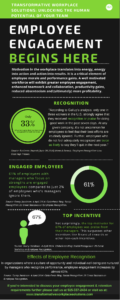A lack of motivation in employees can cause untold frustration for a manager and negatively impact desired outcomes. Today we will discuss the critical role employee motivation plays in creating superior performance for employees and competitive advantage for companies.
What IS Motivation?

Employee Motivation is the inner desire to take action that usually stems from some form of self- interest. Motivating your Employees, on the other hand, involves getting them to do what you need them to do because they FEEL GOOD ABOUT DOING IT!
Motivation in the workplace translates into energy, energy into action and action into results. It is a critical element of employee morale and performance gains.
Benefits of Employee Motivation
A well motivated workforce will exhibit greater employee engagement, enhanced teamwork and collaboration, productivity gains, reduced absenteeism and (ultimately) more profitability.
Just how do we get our teams motivated??
There typically needs to be some form of reward, incentive or benefit for the individual or team, otherwise they will not be motivated or driven to act over and above the mundane call of duty.
A good leader/manager will understand the needs of their team or individuals and will strive to provide what drives each towards excellence.
What forms of motivation do we use?
Motivation can be delivered in numerous tangible and intangible forms, here are five forms of motivation to help your employees perform to the best of their ability:
- Rewards (financial and personal praise): Staff perform better when they are rewarded and acknowledged for their contributions
- Meaning: Seeing that their work contribution adds value and meaning to the organization’s goals and mission
- Valuing: Feeling valued and seeing that management believe and invest in them
- Communication: Employees who can openly communicate their feelings and are “heard” by their boss feel satisfied in the job and workplace
- Relationship: Experiencing genuine interest in who they are as a persona AND an employee from their boss enhances relationships and motivation in the workplace
What may be surprising to many is that financial incentives usually rank pretty low as a means to motivate employees (remember, money buys a dog but it is love that makes it wag its tail).
What is most important, however, is that each of us is individually driven and what motivates one may not have any impact on another. It is critical that leadership within an organization put in place a mechanism to let staff express what motivates them so that management and colleagues have the opportunity to help each employee attain maximum morale and enthusiasm.
Step One
Determining if employees are motivated and engaged is the first step to creating a winning work environment. Typically, employees who work with passion and feel a deep connection to the company are the ones who drive innovation, take more initiative, deliver higher quality work and move the organization forward.
On the other hand, disengaged employees or management are detrimental to your organization because they can infect the rest of your team with negative views, causing conflict. This not only slows productivity, it can cause key members of your team to leave in search of new opportunities.
Identifying these employees and addressing the cause of their unhappiness is critical. If actively disengaged people are unable or unwilling to reenergize and refocus, it may be necessary to remove them from the organization for the good of the entire team.
The middle ground between engaged and actively disengaged employees is reserved for the not engaged — essentially, these people are “checked-out.” By sleepwalking through their workday, they are only putting time — not energy or passion — into their work.
As a result, they can negatively impact productivity and quality of work. Fortunately, those falling into this middle ground usually have the best potential for being reengaged.
What to do?
Once you have a rough idea of which group your employees fall into, it’s time to take action. Creating an environment where employees feel that their contributions are integral to the overall success of the organization can be a challenge, but it is certainly worth the effort.
“People work for money, but they go the extra mile for recognition, praise and rewards” – Dale Carnegie